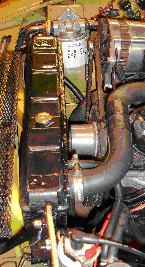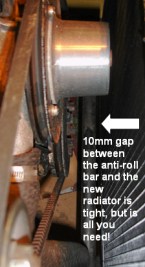399
High-efficiency four-row radiator for the V8
Gordon
Hesketh-Jones reported in late 2008 that he was installing a
modified radiator to his well campaigned V8. Now following a
trip to Spain, he provides feedback on how it has performed.
(Feb 09)
If
you scan through the V8 Workshops Notes Contents List you will
see that there have been more than 20 Notes on overheating,
cooling and radiators, some going back as far as 1979. There
have been more recent contributions by Roger Parker, Bob Owen,
Bill McCulloch and myself, but the problem has not been solved
simply because the engineers at Abingdon were faced with a Mission
Impossible - to shoe-horn a V8 engine with more than twice the
volume and heat-generating capacity into an engine bay previously
used for a small four-cylinder engine. In addition, these engineers
had to produce this new model at maximum speed and with minimum
development time and cost.
Some
years ago we drove down from the Danish border to visit Allan
and Eva Doyle near Nuremberg, a distance of nearly 500 miles.
For the whole day the large temperature gauges on the motorway
service stations showed the ambients as being from 25°C
to an eye-opening 43°C, yet whilst our V8's temperature
gauge rose to around a reasonable 100°C (i.e., in line with
the ambient increase), we had no engine worries and the petrol
consumption was 32/34mpg. To me this proved that with a decent
flow of air through the radiator, the engine would be properly
cooled. However, as we all know the problems arrive not on fast
driving with plenty of airflow, but when we are trickling along
in traffic-clogged towns and cities.
Many of us have approached this problem with a variety of solutions
but none with perfect success, so I decided it was time to do
a bit of lateral thinking and tried to think about which other
vehicles have powerful engines, but virtually always travel
at low speeds. The answer (to me at least) was that tractors,
earth-movers and JCBs are in this category so I contacted our
local radiator supplier in Plymouth - "local" means
less than 100 miles when you are in West Cornwall. They understood
the problem and told me that G M Radiators near Glasgow make
these specialist radiator cores. After discussions with them
the proposal was to make a 4-core unit instead of the standard
three cores, with 11 rows of fins per inch instead of 7. Crucially,
the tubes would be 13.5mm O/D (2.2mm wall thickness so 9.1mm
I/D) compared to the standard tubes which are 9.3mm O/D (4.9mm
I/D). These new tubes therefore have an internal cross-sectional
area of 14.3 mm² compared to 7.69 mm² for the standard
tubes, i.e., virtually double the cross sectional area leading
to faster water flow through the radiator. The tubes are 355mm
long - the same as at present so no change to the height or
depth of the header tank and the bottom tank - and, crucially,
the top and bottom hose connections. |
 |  |
Being 4-row,
the radiator is approximately 25mm deeper front to back so obviously
is a tight fit in my crowded engine bay. At the front there
is a gap of approximately 8mm between the valance and the front
of the core, whilst on the engine side there is around 10mm
between the core and the anti-roll bar. The core is still approximately
25mm clear of the fan pulley. The brackets, header tank and
bottom tank off my old radiator were retained then welded/soldered
onto the top of the new core - leading to the "shoulders"
approximately 7mm wide shown in the photo. As the radiator intrudes
into the engine bay, the top and bottom hoses had to be shortened
by around 15mm to avoid creating sharp bends.
I measured the coolant capacity of the standard radiator at
3.1 litres and the revised version at 4.0 litres so there has
been a useful improvement. From my mileage of around 4,500 so
far, I have noticed that the heat output from the cabin heater
has increased dramatically - possibly due to the fact that the
coolant now circulates through the system far more quickly with
the larger-diameter radiator tubes; from what I can recall,
most of the coolant flow passages in the engine are at least
10mm I/D so the standard radiator tubes of 4.9mm I/D would have
presented a restriction in the water-flow speed. This improvement
in cabin heater output was most welcome for this Winter's trip
to France and Spain.
Does it work? Well, we crossed the dreaded Boulevarde Periphique
in the evening rush-hour (45 minutes of stop-start inching due
to ferry delays); the ambient was around 12°C and the V8's
temperature gauge rose just slightly - but not enough to bring
the fans on!
At around £265 the price is virtually three and a half
times the cost of the standard MGB Hive V8 version but only
slightly higher than the Hi-Flow MOSS MGB versions. As it does
the job well, I am not complaining! If you want to follow this
route - ask your local radiator people to contact G M Radiators
- who only supply to the trade. http://www.gmradiator.co.uk/
|



